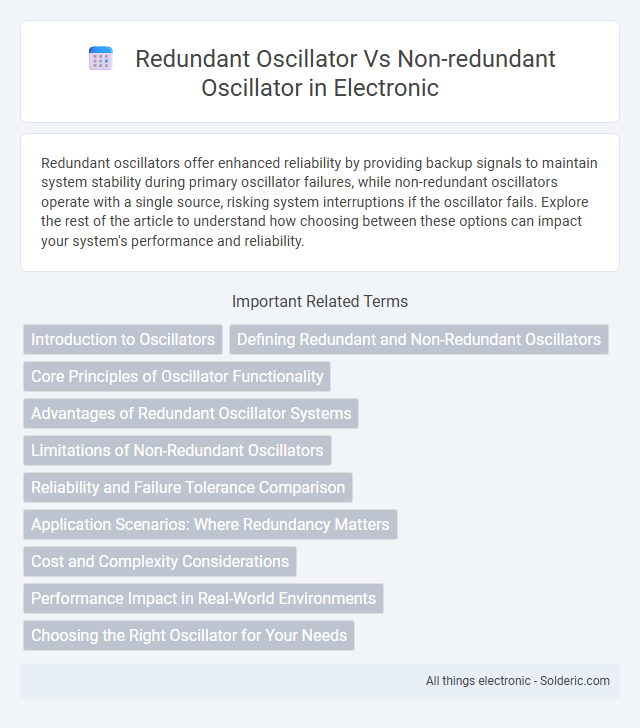Redundant oscillators offer enhanced reliability by providing backup signals to maintain system stability during primary oscillator failures, while non-redundant oscillators operate with a single source, risking system interruptions if the oscillator fails. Explore the rest of the article to understand how choosing between these options can impact your system's performance and reliability.
Comparison Table
| Feature | Redundant Oscillator | Non-Redundant Oscillator |
|---|---|---|
| Definition | Oscillator system with backup units for reliability | Single oscillator unit without backup |
| Reliability | High, continuous operation during failures | Lower, operation depends on one oscillator |
| Failure Tolerance | Can tolerate oscillator failure without system down | Oscillator failure causes system downtime |
| Cost | Higher, due to additional components | Lower, fewer components needed |
| Complexity | More complex design and maintenance | Simpler design and maintenance |
| Use Cases | Critical systems requiring high uptime (e.g., telecom, aerospace) | Non-critical systems or cost-sensitive applications |
| Power Consumption | Higher due to multiple oscillators | Lower, single oscillator operation |
| Switching Mechanism | Automatic failover switching | No switching, only single oscillator |
Introduction to Oscillators
Oscillators are electronic circuits or devices that generate repetitive signals, often sinusoidal or square waves, used in timing, frequency synthesis, and signal processing applications. A redundant oscillator system incorporates multiple oscillators to ensure continuous signal generation in case one fails, enhancing reliability in critical systems like aviation or telecommunications. Non-redundant oscillators rely on a single oscillator source, making them simpler and cost-effective but susceptible to failure without backup.
Defining Redundant and Non-Redundant Oscillators
Redundant oscillators consist of multiple clock sources designed to provide backup in case one oscillator fails, ensuring continuous and reliable signal generation in critical systems. Non-redundant oscillators rely on a single clock source without backup, making them more vulnerable to signal loss or timing errors if the oscillator malfunctions. The choice between redundant and non-redundant oscillators depends on the required system reliability and tolerance for downtime.
Core Principles of Oscillator Functionality
Redundant oscillators incorporate multiple oscillator units to ensure continuous signal generation by automatically switching to a backup unit if the primary fails, enhancing system reliability in mission-critical applications. Non-redundant oscillators rely on a single oscillator source, making them simpler and more cost-effective but vulnerable to signal loss if that oscillator malfunctions. Your choice between these depends on the required reliability and the criticality of maintaining uninterrupted oscillator functionality.
Advantages of Redundant Oscillator Systems
Redundant oscillator systems offer enhanced reliability and fault tolerance by incorporating multiple oscillators that ensure continuous signal generation even if one oscillator fails. This redundancy reduces the risk of system downtime, making them ideal for critical applications like telecommunications, aerospace, and data centers. Improved signal stability and seamless failover capability are key advantages that maintain precision timing and synchronization.
Limitations of Non-Redundant Oscillators
Non-redundant oscillators lack backup components, making them vulnerable to failure that can disrupt system timing and lead to operational downtime. Their single-point-of-failure design reduces reliability in mission-critical applications where continuous timing accuracy is essential. You should consider redundant oscillators to ensure system stability and minimize risks associated with oscillator failure.
Reliability and Failure Tolerance Comparison
Redundant oscillators enhance system reliability by providing backup clock signals, ensuring continuous operation if the primary oscillator fails. Non-redundant oscillators offer simpler designs but are vulnerable to single points of failure, risking complete system downtime. Your choice impacts failure tolerance, with redundant configurations significantly improving fault resilience in critical applications.
Application Scenarios: Where Redundancy Matters
Redundant oscillators are crucial in applications requiring high reliability, such as aerospace, telecommunications, and medical devices, where continuous operation is essential and failure could lead to catastrophic consequences. Non-redundant oscillators are typically used in less critical environments where occasional downtime is acceptable, reducing cost and complexity. Your system's operational continuity benefits significantly from redundant oscillators in scenarios demanding fault tolerance and seamless performance.
Cost and Complexity Considerations
Redundant oscillators increase system reliability by providing backup frequency sources but raise cost and complexity due to extra components and intricate design requirements. Non-redundant oscillators offer a simpler, more cost-effective solution suitable for less critical applications where single-point failure risk is manageable. Your choice depends on balancing budget constraints against the necessity for fault tolerance in your specific use case.
Performance Impact in Real-World Environments
Redundant oscillators enhance system reliability by providing backup clock signals, minimizing downtime caused by oscillator failures and ensuring continuous operation in critical applications. Non-redundant oscillators, while simpler and more cost-effective, risk performance degradation or total system halt when the primary oscillator fails, especially in harsh environments prone to vibration or temperature fluctuations. In real-world scenarios, redundant oscillators maintain timing accuracy and system stability by seamlessly switching to a backup source, significantly improving overall performance resilience.
Choosing the Right Oscillator for Your Needs
Choosing the right oscillator for your needs depends on the criticality and reliability requirements of your system. A redundant oscillator provides a backup signal source, minimizing the risk of oscillator failure and ensuring continuous operation in mission-critical applications like telecommunications and aerospace. Non-redundant oscillators suit less critical systems where cost and simplicity are prioritized over fault tolerance.
Redundant oscillator vs Non-redundant oscillator Infographic

 solderic.com
solderic.com